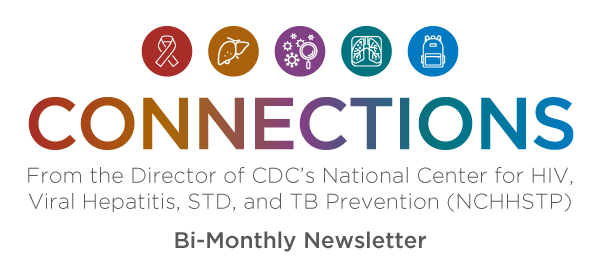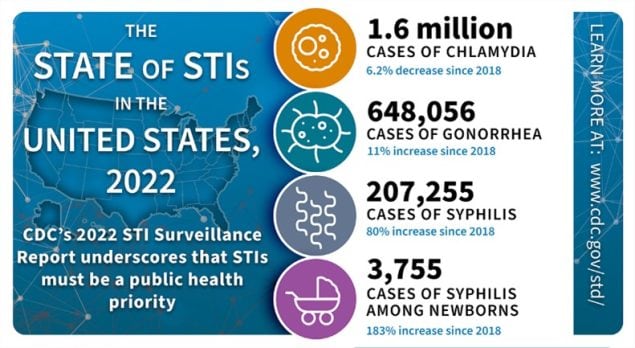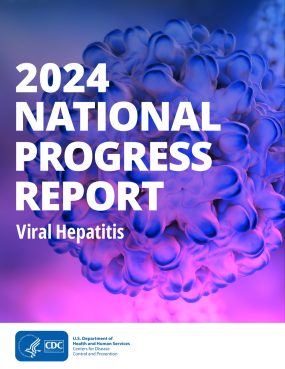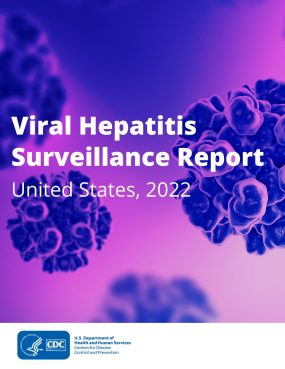Connections (April-May 2024)

Issue II (April-May 2024)
From the Director – Jonathan Mermin, MD, MPH
In the United States, a large number of people have undiagnosed chronic viral or bacterial infections. There are over a million people with undiagnosed hepatitis C, over 300,000 with undiagnosed hepatitis B, over 150,000 with undiagnosed HIV, and the vast majority of over 8 million people with latent TB infection are undiagnosed. The path to life-saving treatment starts with testing. Increasingly, NCHHSTP is working to bring the power of diagnosis closer to the people who need it. One focus has been self-testing. CDC collaborated with Emory University on several studies that showed people who order free HIV self-tests online can test themselves accurately, and if positive get linked to HIV care.
Following the research, we collaborated with Emory, Building Healthy Online Communities, NASTAD, and others to expand testing through Together TakeMeHome (TTMH) which focused on bringing self-tests to people disproportionately affected by HIV. Between the launch March 13, 2023, and January 22, 2024, the program successfully delivered 391,600 HIV self-tests to over 195,500 unique people in all 50 states, Washington, D.C., and Puerto Rico.
- 50% of orders were from Ending the HIV Epidemic in the United States (EHE) initiative jurisdictions, about 10% from rural areas.
- About 8% of orders were from a Spanish-language version of the website with orders from the Spanish site from all 50 states.
TTMH is a key component of CDC’s Let’s Stop HIV Together campaign, with a goal of distributing 1 million free HIV self-tests over five years – 200,000 self-tests per year – to groups disproportionately affected by HIV.
HIV self-testing is important because it can help provide testing to people who do not have easy access to in-person testing services and can reduce stigma for those who may be reluctant to go for an in-person HIV test. TTMH also opens the door for participants seeking additional services after HIV self-testing, such as STI testing and PrEP initiation. Programs like TTMH demonstrate that together, we can create systems that tackle HIV disparities and enhance HIV testing efforts among people most affected by HIV.
Transgender women, especially transgender women of color, are disproportionally affected by HIV but there was no surveillance system that collects comprehensive, representative, HIV-related information for this population. To address this gap, CDC developed the National HIV Behavioral Surveillance Among Transgender Women (NHBS-Trans). Findings from NHBS-Trans can help guide clinicians and community leaders to improve access for transgender women to HIV prevention and treatment services. For more information go to the MMWR supplement: Overview and Methodology of the National HIV Behavioral Surveillance Among Transgender Women — Seven Urban Areas, United States, 2019–2020 | MMWR (cdc.gov)
Summary Sources: Kanny D, Lee K, Olansky E, et al. Overview and Methodology of the National HIV Behavioral Surveillance Among Transgender Women — Seven Urban Areas, United States, 2019–2020. MMWR Suppl 2024;73(Suppl-1):1–8. DOI: http://dx.doi.org/10.15585/mmwr.su7301a1.

Updated Introduction to Tuberculosis Slide Set
CDC has updated the Introduction to Tuberculosis slide set to include information about directly observed therapy (DOT) and video directly observed therapy (vDOT). The slide set is a great tool for people who are not familiar with TB and provides an overview of the latest information on TB in the United States. Check out these new updates.
American Medical Association Screening Toolkit
The American Medical Association (AMA) has released a new toolkit, American Medical Association (AMA) HIV, STIs, Viral Hepatitis and LTBI Routine Screening Toolkit. Explore new training materials, learn more about routine screening and access AMA’s webinar sessions.
2022 STI Surveillance Report

On January 30, CDC released the 2022 STI Surveillance Report. The annual report – which highlights that the syphilis epidemic continues to escalate – underscores that STIs must be a public health priority. In 2022, yet again, more than 2.5 million cases of syphilis, gonorrhea, and chlamydia were reported in the United States. The most alarming concerns center around the syphilis and congenital syphilis epidemics, signaling an urgent need for swift innovation and collaboration from all STI prevention partners.
CDC Releases 2023 Provisional U.S. Tuberculosis Data
The United States continues to have one of the lowest tuberculosis (TB) rates in the world. However, U.S. TB data show an increase in reported cases during 2023. It’s more important than ever for clinicians to “Think TB” when treating patients with respiratory symptoms, especially if they have lived in or traveled to countries where TB is more common. Learn more in the latest NCHHSTP Dear Colleague letter.
Viral Hepatitis Surveillance and National Progress Report

CDC recently published the 2022 Viral Hepatitis Surveillance Report and the 2024 Viral Hepatitis National Progress Report. These reports contain hepatitis A, hepatitis B, and hepatitis C surveillance data that inform the nation’s viral hepatitis response and progress towards national elimination goals of reducing viral hepatitis infections and related mortality and disparities.
From 2021 to 2022, the number of newly reported cases of hepatitis A decreased 60%. Because many people remain susceptible to hepatitis A virus infection, vaccination is essential to achieve our national hepatitis A goals and prevent future outbreaks.

After decreasing during 2020-2021, the rate of newly reported acute hepatitis B cases remained stable in 2022. To meet our goals, we need to expand access to hepatitis B vaccination, promote universal testing and simplified treatment criteria and ensure expanded access to hepatitis B care.
The rate of reported acute hepatitis C cases decreased for the first time in 2022. CDC continues to invest in prevention strategies, including increased access to testing, counseling, and medication-assisted treatment through syringe services programs, to save lives and help communities fight viral hepatitis. We must increase efforts to get everyone with hepatitis C tested and cured, including testing perinatally exposed infants at age 2 to 6 months.
CDC HIV STD Mpox Commercialization
Bavarian Nordic, the maker of JYNNEOS, has opened ordering of the vaccine through commercial wholesalers. To ensure equitable access to JYNNEOS, health departments can continue to use the supply previously ordered from HHS and order the vaccine from the HHS supply to support access where commercial product is not yet available or accessible. Additional information will be available on the HHS website in the coming weeks. Please contact your ASPR Regional Administrator with any questions.
Receive Connections Bi-Monthly Newsletter in your Inbox.
Dr. Jonathan Mermin
@DrMerminCDC

Lauren M Hughes
Do you have feedback, story ideas, content you would like to see in the newsletter? Send me a note!
Get Connections in your inbox






